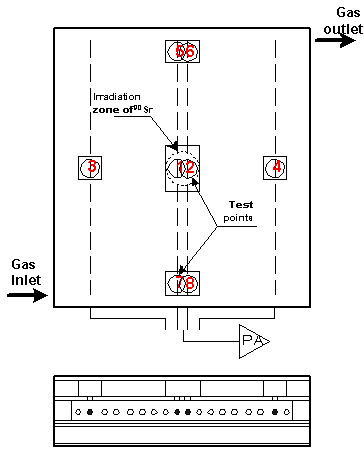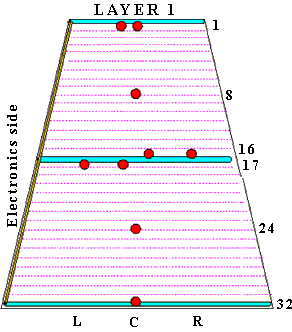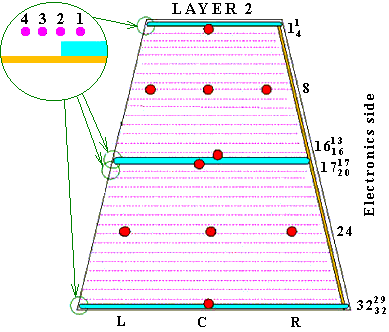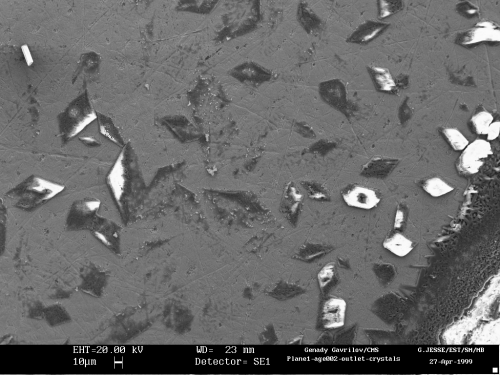|
|
||||||||||||||
|
|
|
|
|
|
|
|
|
|
|
|
|
|
|
|
| CMS ageing tests at PNPI | CMS ageing tests at CERN |
|---|---|
The ageing studies of the CMS EMU prototypes in PNPI were performed with the 90Sr source at the Ageing Test Station. The ageing tests were carried out with three types of working gas mixtures:
Ar(30%)+CO2(50%)+CF4(20%), Ar(40%)+CO2(50%)+CF4(10%) andAr(30%)+CO2(70%). The last mixture was investigated to estimate a contribution of CF4 to the ageing resistance of the CMS chambers.
The accumulated charges were:
Gas mixture Dose,C/cm Ar(30%)+CO2(50%)+CF4(20%) 13.56 Ar(30%)+CO2(70%) 0.76 Ar(40%)+CO2(50%)+CF4(10%) 13.35+2.2

The set-up
The tests were performed using four identical prototypes of the CMS chambers with the active area of
175 x 240 mm2 . One of them was used as a reference, and three others as test chambers. The applied high voltage for each gas mixture was chosen so as to provide the gas gain4x104 . The gas flow was kept at the rate75 volumes per day till the accumulated charge13.56 C/cm was obtained. The rest2.2 C/cm charge was accumulated with small gas flows0.1 V/day and1 V/day .The given scheme presents the test point distribution and cross section of the prototype chamber.
Ageing results
For
Ar(30%)+CO2(50%)+CF4(20%) mixture gas gain reduction was not observed up to the accumulated chargeQ = 13.56 C/cm. However, the dark current in the chamber was noticeable starting already fromQ = 2 C/cm. The absence of the CF4 in the Ar/CO2 gas mixture caused fast aging deterioration, and
Q = 0.2 C/cm was enough to obtain 50% of the gas gain reduction.In the test with
Ar(40%)+CO2(50%)+CF4(10%) mixture the gas gain reduction and the dark current increase were not observed up toQ = 13.35 C/cm. The reduction of the gas flow rate to0.1 volume per day caused 50% of the gain decrease due to the gas pollution by fragments of dissociated gas molecules. The gain restored after turning back to the1 volume per day flow rate.Studies of the cathode and wire samples with SEM/XEM methods find the traces of silicon. It may be assumed that the most probable source of the chamber contamination is the Si-reach RTV sealing and cathodes honeycomb FR4.
back to the top
CMS ageing test at CERNThe ageing chambers were irradiated with the
137Cs (2 GBq) source at the GIF (Gamma Irradiation Facility).
For two tested chambers the doses were:
Chamber ID 001 002 Layer 1 Dose (C/cmwire) 0.281 0.250 Layer 2 Dose (C/cmwire) 0.144 0.107
The set-up
The chambers had a modified design of a bottom segment of an ME2/1 chamber, with addition of an extra guard strip in the middle of the sensitive volume. The working gas mixture was
Ar(40%)+CO2(50%)+CF4(10%) and the gas flow rate was 1 volume per day. The working point was chosen so as to provide the average gas gain at the level of4x104 . The location of the test points is shown below.

|

|
Results
The CMS EMU prototype 002 after ageing run has been dismounted. The cathodes and wires planes have been visually inspected.
Cathode surface:
Visual inspection of the cathode planes determined the white coating covering practically the whole cathode surface.The detailed analysis using SEM/XEM methods has shown the presence of the silicon, calcium and bromine on the cathode surface.


The white crystals at the cathode surface are seen at the SEM-micrograph. The corresponding XEM-spectrum is shown below. The presence of the bromine and calcium peaks allows to conclude that the main source of the silicon deposits was the mashined fiberglass of the cathode honeycomb.

Anode wire surfaces:
The wire analysis demonstrated clear presence of the silicon and carbon deposits on the wires. It must be noted that the most noticeable amount of deposits was observed on the wires located in the vicinity of the guard strips. The most typical view of the coated wire is presented.
back to the top